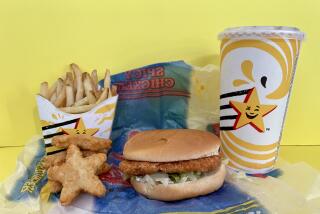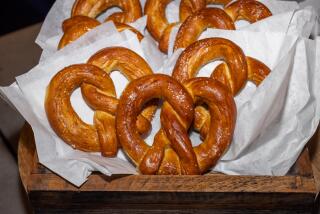At These Prices, Meatloaf Won’t Do
Looking impassively at the plate of dark-green asparagus with garlic that sits before him, S. Zainul Aljunied raises one of the juicy 5-inch stems to eye level and gives it a quick look. Then he starts complaining.
“It’s too long,” he says politely but firmly to Bob Rosar, the chef who prepared the dish and now stands with his hands clasped behind his back as he accepts Aljunied’s critique. Figuring the stem’s length makes it too awkward to eat, Aljunied tells Rosar: “Change it.”
But Aljunied is pleased with another dish, a Cornish game hen with sauteed button mushrooms in red wine sauce. “Very nice color,” he says to Rosar. “Excellent.”
Aljunied isn’t dining at the Four Seasons. Rather, he’s evaluating the food that Singapore Airlines plans to serve its passengers early next year, food that’s been prepared to the airline’s strict specifications by Gate Gourmet, for which Rosar is executive chef at Los Angeles International Airport.
This review is part of Aljunied’s job as the southwestern U.S. manager for the airline, which is renowned for its sterling service, including its excellent food. Aljunied and other Singapore Airlines executives, in fact, would no doubt stand tall in the eyes of thousands of people who fly U.S. airlines each day and rue the squishy roast-beef sandwiches, lukewarm Salisbury steaks and puny box lunches they’re often served.
To be sure, it’s not really fair to compare United, Delta and the other domestic airlines with Singapore Airlines or many other international airlines when it comes to food. Domestic carriers are flying tens of thousands of flights each day over both short and long distances, and they’re fixed on keeping down costs, including food costs. That means not much more than a snack on short hauls and dinner on a transcontinental flight.
But the international airlines fly more long-haul routes across vast oceans--flights in which good meals are almost mandatory in exchange for keeping passengers in the sky for several hours and charging them several thousand dollars for a first-class seat.
Singapore Airlines doesn’t disclose the average amount it spends on food per passenger throughout its worldwide operations, as do U.S. carriers. But Singapore’s LAX operation alone says it spends between $15 and $25 for its economy meals and between $35 and $45 for first-class fare.
The major U.S. airlines, meantime, spent an average of $4.81 per passenger in the fourth quarter of 1999, with American Airlines topping the list at $8.44 per meal. Those figures cover all classes of passengers and exclude liquor and other beverages.
That difference isn’t lost on Singapore Airlines’ frequent fliers, such as Harvey Niskala, a project manager at Glorious Land Co., a real estate developer in Industry, who makes frequent trips to Asia to meet investors and clients. His only complaint? The airline has so many choices that sometimes he’s tempted to try an Asian meal that doesn’t suit him.
“It’s not because of its preparation or the way it’s presented; it’s just a dish I don’t like,” Niskala said. But overall he loves the carrier’s food. “I like the variety. It isn’t your typical chicken or steak dish served on an airline.”
Singapore Airlines spends roughly $700 million for food each year, and it routinely wins awards for service, food included, in customer surveys.
Indeed, in its September issue, Business Traveler magazine named the airline and its archrival, Cathay Pacific of Hong Kong, as the two best long-haul airlines in the world for business passengers.
Fortune magazine, in its list of most-admired global companies, has just named Singapore first among the airlines.
Singapore Airlines also doesn’t mind paying more than average for food, because it’s obsessive about its reputation for service. “Of course we look at budgets, but that’s not our main criteria,” Aljunied said.
The airline recently invited The Times to see how it goes about choosing what to serve on board. So for those travelers who got only peanuts and a soft drink on their last flight, here’s a look at how the other half eats--at least in the sky.
Flying first class? The airline is testing blackened Cajun-spiced scallops for your appetizer and red snapper baked with spaghetti and chili oil for your main course. Dessert? How about mixed berries in champagne jelly with citrus broth?
Economy passengers, meanwhile, must settle for sesame-coated prawns with coleslaw as an hors d’oeuvre; a main course of perch roasted with potatoes, Kalamata olives and capsicums; and mint jelly with fruits or ice cream for dessert.
But exactly how these dishes are prepared, how they look, how much food they contain and how they’re served--at least on flights into and out of LAX--will ultimately be decided by Aljunied and his staff.
What are their main requirements? “Eye appeal is important, and the taste of course,” explained Aljunied, a 36-year veteran of the airline and a Singapore native who has worked for the carrier in 18 countries.
“But most important in first class is eye appeal,” he said. “When you pay almost $8,000 for first class to Singapore, you want to get the best meal. So the passengers are very critical.”
So are Aljunied and his crew, who do this review four times a year. The airline does similar ones at most of its 94 destinations around the globe. In this case, Aljunied’s team met at Gate Gourmet’s LAX facility, where a long, U-shaped table was set with more than 60 dishes that would be served to first-class, business-class and economy passengers aboard Singapore Airlines’ two daily flights from LAX to Singapore.
One is an 11-hour flight that makes a stop in Tokyo. The other is a 13-hour flight with a layover in Taipei, Taiwan. Together they require 1,600 meals a day from Gate Gourmet, a unit of SAirGroup, which also owns Swissair.
Inside the U stood Rosar, a veteran airline chef with ruddy cheeks, a mustache and curly hair that poked out beneath his tall paper chef’s hat. He was accompanied by other chefs, who ferried back and forth from the table to the kitchen whenever Aljunied and his staff wanted changes made to the dishes.
They started with first class, and Aljunied and his team--including Winston Teo, who heads catering for the airline at LAX, and Raphael Ng, Singapore Airlines’ LAX station manager--stopped at each dish merely to decide whether it looked good. To check all the dishes took nearly two hours. Later they went around again to check the taste.
They hadn’t gone far when Aljunied griped about a mixed-greens salad. “This I would call unacceptable,” he told Rosar. “Too much oil.”
He also wasn’t happy with a wok-fried beefsteak with light oyster gravy because, though the dish looked exquisite on the table, Aljunied said, there was no way a busy flight crew would be able to replicate the dish in the airplane’s galley.
“They don’t have the time,” he told Rosar.
On they went, checking the grilled prawn teriyaki, the chilled caviar hors d’oeuvre, the Japanese clear soup with sliced fish, the hot smoked salmon and the crab risotto cake.
Indeed, the airline tweaks its menu to accommodate both its heavy Singaporean traffic and Americans who are flying to Singapore. So there are plenty of Asian specialties on the table as well as California cheeses.
About two months before this review, Singapore Airlines had sent Gate Gourmet--which acquired the Dobbs airline-food business last year--a basic outline for the menu. But when it came to a dish anchored with a chicken breast, Aljunied made it clear that Gate Gourmet had followed the “book” too closely.
The chicken had a large bone in it, which made it hard to cut and eat in an airline seat. It also looked unattractive. “Don’t just follow the book!” Aljunied told Rosar and his boss, John Birckhead, Gate Gourmet’s LAX general manager. “Change it. This is not appealing.”
And Ng was annoyed with the salad for economy class, arguing that it was too large for its plastic bowl--especially for someone eating from the tray of an airplane seat. “When you mix it around with the dressing, it will be all over the place,” he said.
All this nit-picking might make Birckhead dread Singapore Airlines’ reviews, but the 27-year veteran of airline-food service said he can’t take it personally if he wants to do his job right.
“We’ve had chefs who haven’t made it with us because their pride gets in the way,” Birckhead said.
But he acknowledged that Singapore Airlines is his toughest critic, adding: “That’s why they keep winning awards.”
(BEGIN TEXT OF INFOBOX / INFOGRAPHIC)
Sky Food
Singapore Airlines, known for its in-flight cuisine, spends much more on food than U.S. airlinesthat fly many shorter routes and are more focused on costs. Here’s a sample of one of the main dishes offered on long-haul first-class or business-class flights:
*
Menu
Singapore Airlines
Snapper baked en papillote with spaghettini
American Airlines
Shrimp and scallop risotto
United Airlines
Rack of lamb with foie gras in puff pastry
Continental Airlines
Grilled sea bass with cream sauce
Northwest Airlines
Beef tenderloin with cherry butter
Delta Air Lines
Back-fin crab cakes with mustard-herb sauce
*
What They Spend
A comparison of the major carriers’ food expenses (excluding beverages). Food cost per passenger in the fourth quarter of 1999:
Singapore: $15 (up to $45*)
American: 8.44
United: 7.79
Continental: 5.23
Northwest: 4.97
Delta: 4.16
Sources: Aviation Daily, U.S. Transportation Department, airline reports
*Estimated range
More to Read
Sign up for The Wild
We’ll help you find the best places to hike, bike and run, as well as the perfect silent spots for meditation and yoga.
You may occasionally receive promotional content from the Los Angeles Times.







